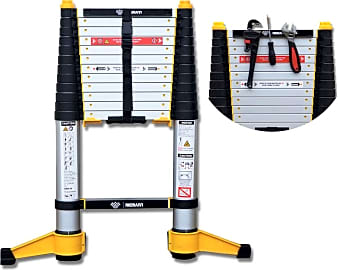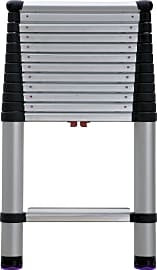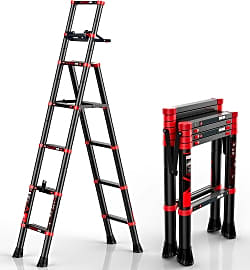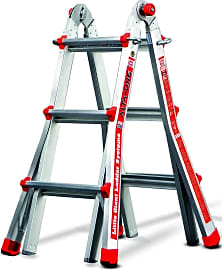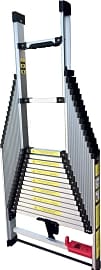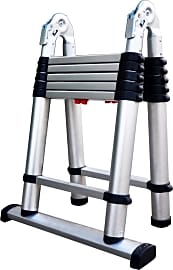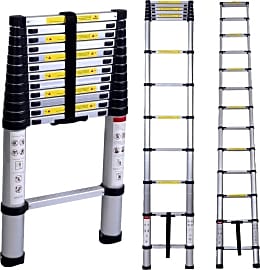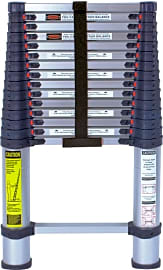The 10 Best Telescoping Ladders

This wiki has been updated 41 times since it was first published in March of 2015. A decent ladder will make cleaning gutters or reaching the top shelf a lot easier. But if space is limited, try one of these telescoping models, which come in conveniently compact packages and are ideal for contractors and handypersons who need to transport them from the shop to the job site and back. Our selections include a variety of options to meet every need and budget. When users buy our independently chosen editorial picks, we may earn commissions to help fund the Wiki.
Editor's Notes
May 04, 2021:
A telescoping ladder is designed for convenience, ease of transport, and storage, and as such should be relatively lightweight and easy to adjust. There are several popular styles available from A-frame and single extension, to multifunctional combination ladders. Their maximum height and their size when collapsed are the most important considerations when choosing the most suitable model.
In this update, we added several new models to the ranking, making a more comprehensive list. The Louisville FE3224 was removed, because although a high-quality option, it is actually an extension ladder. In its place, we selected the Riemann Heavy Duty Collapsible, which features pivoting stabilizer arms and a magnetic tool holder built into the top rung. The Charahome folding and the Telesteps 10ES are two A-frame style models that have twin extending sections that can be set at different heights for use on staircases or on uneven or sloped surfaces. The latter features a patented one-touch release that automatically extends and retracts the ladder, making it a good choice for less capable users. Finally, we included the HYDT Heavy Duty, which has a unique design that makes it more stable than most of its counterparts, however, it isn't as compact when collapsed so may be better suited for keeping at home rather than for transporting in the trunk of a car.
January 03, 2020:
Removed the YiHai Portable because of availability concerns. Removed the IdealChoiceProduct Steps because it is essentially a clone of the WolfWise Tall.
Added the Louisville FE3224 and the Vulcan 17T11G1. I added the Louisville because it features what may be the most common ladder design used by construction workers - the quick-latch and rope. What makes this appealing is that adjusting the height is much quicker than folding and extending ladders like the Vulcan or the Werner MT-26. As far as home ladders go, the Werner is my favorite because, while slower to adjust, time is not as much of an issue and it is the only ladder you'll ever need. It has a configuration for nearly any task, it's very stable, and extremely compact. The simple shear pin lock system means that there is no concern that the ladder won't hold the 300lbs it is rated for.
Use caution when using ladders and ensure that they are stable before climbing.
Special Honors
Screw Fix This international home improvement company offers straightforward and affordably priced products. Their extensive range of ladders includes a variety of combination ladders that can be converted into a work platform or used on uneven surfaces and gradients. screwfix.com
Worhan This UK-based company has a large range of high-quality aluminum ladders, including single and double telescoping, multipurpose combination, and foldable stepladders. They also make one of the longest in the industry with a 5.6-meter extension. worhan.co.uk
Time To Climb
The telescoping ladder is also invaluable to professional contractors when it comes to multiple worksite locations with varying heights for completing projects.
There's something to be said about a ladder that is more than just a piece of long and sturdy aluminum that lets you climb onto the side of a building. Perhaps you need more versatility than that. What if you could have a ladder that was capable of extending into multiple configurations, collapsing down in seconds without risk of injury, and super easy to store and take just about anywhere? Whether you're a construction worker or you just like fixing things around the house in hard-to-reach places, you'll need one of these telescoping ladders to get the job done.
Setting the telescoping ladder apart from conventional ladders is its ability to both retract and extract to reach high places, while also being capable of collapsing down quickly to a very compact size for convenient closet storage. The telescoping ladder is a hybrid between a regular step ladder and an extension ladder. What this means is that a telescoping ladder can be extended only as much as you need to reach a certain area without having to maximize its length entirely, making this style of ladder a truly multifunctional tool for performing close detail work in a home, apartment, condo, tool shed, or office. The telescoping ladder is also invaluable to professional contractors when it comes to multiple worksite locations with varying heights for completing projects.
Finally, not only do these ladders vary in length between twenty-seven inches and up to fifteen feet, but they can be set up in multiple configurations for use in tight spaces and even on staircases.
Reach New Heights, Not Frights
Telescoping ladders offer many advantages to both professionals and homeowners alike. Let's dig a bit deeper into some of them to determine how to best use our list. Most telescoping ladders are made from lightweight and durable aluminum, so they're typically easy to transport to and from job sites. This is particularly important if you're a professional contractor and need to maximize the available space in your car or truck to accommodate the rest of your equipment when traveling from site to site. The last thing you need is a bulky ladder that's difficult to adjust or one that poses a potential safety hazard when you need to collapse and expand it.
This will all come in handy if you ever have to work in wet or windy conditions outdoors.
One must pay attention to the weight capacity of the ladder being chosen. Many telescoping ladders support up to three hundred pounds, giving you the confidence that the ladder will remain stable if you find yourself moving around a lot as you work. On that same note of safety, be certain the ladder you choose is equipped with some combination of non-slip feet, rung, and rail material for added stability and a comfortable grip as you ascend and descend. This will all come in handy if you ever have to work in wet or windy conditions outdoors. If you work with a lot of heavy loads, having a ladder with extra-wide steps and treads will also be a strong benefit.
To be certain that your hands don't get caught or crushed when you expand and collapse your ladder, those with built-in angled thumb releases and no-pinch closures are key safety features that are important during setup and when you finish your work for the day.
Many ladders provide their own visual identification locking systems. These can take the form of dots or colored tab locking indicators on different sections, which deliver added assurance that the ladder has been extended properly and is ready for use.
Some ladders also feature 360-degree hinges for improved ease of movement and often have built-in carrying handles.
So, do I actually need a telescope to use it? Not in the literal sense, but if you consider yourself a stargazer who loves astronomy, then you could certainly use this type of ladder technology to assist you on your way up to the roof of your home at night to view the sky.
From Rung To Rung: A Quick Telescoping Ladder History
The concept of a ladder is nothing new, as the first reference to the use of one dates as far back as Mesolithic times with a rock painting that is over 10,000 years old and found in the Spider Caves in Valencia, Spain. The painting depicts two people using a rudimentary ladder (possibly made from grass) to reach a beehive for harvesting honey.
Originally made from wood, Balsley placed hinges at the top of his ladder, which allowed users to fold and store the ladder.
The first step ladder was invented in 1862 by John H. Balsley from Dayton, Ohio. Originally made from wood, Balsley placed hinges at the top of his ladder, which allowed users to fold and store the ladder.
In the 1970s, an entrepreneur named Harold ‘Hal’ Wing was working in Germany for an insurance company where he met both a painter and decorator who were fed up with having to use many different ladders for different types of jobs. As an answer to this problem, Hal Wing developed the first multipurpose, telescoping and articulating step ladder and began selling them from his own garage in 1972, also having established The Little Giant Ladder company in America. Little Giant is still one of the largest and most successful ladder manufacturers today. Other comparable manufacturers include Telesteps and Xtend and Climb among others.


